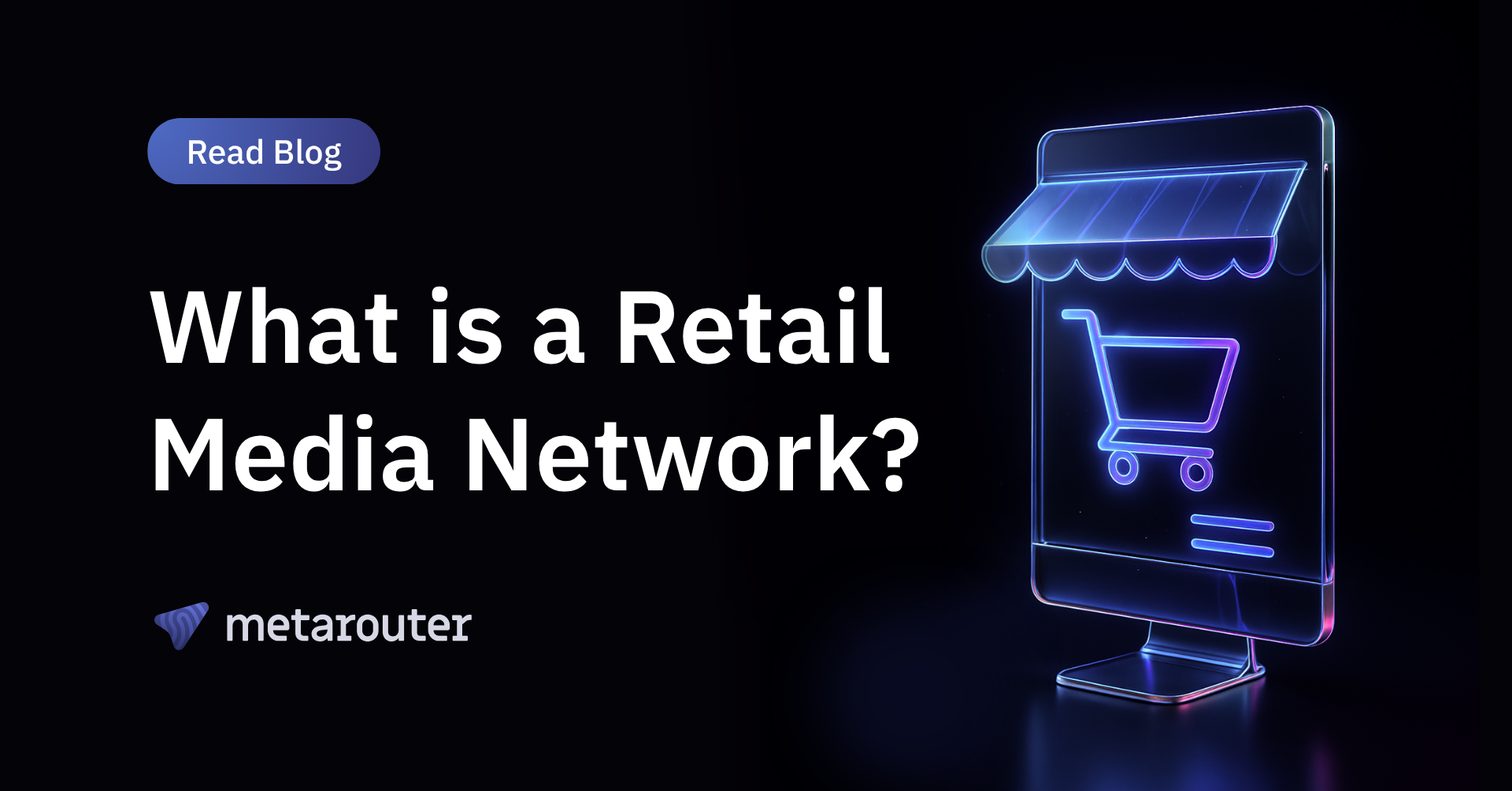What is a Retail Media Network? Preparing Your Data for the Future of Advertising
They've become a fundamental component of modern digital advertising infrastructure, one that demands technical sophistication to execute properly.

When Amazon reports that its advertising business generates more than $40 billion in annual revenue, surpassing global TV networks, it becomes clear that retail media networks represent more than just another advertising channel. They've become a fundamental component of modern digital advertising infrastructure, one that demands technical sophistication to execute properly.
For professionals entering this space, understanding retail media networks requires looking beyond the surface-level promise of "advertising where people shop." The real complexity lies in the data architecture, identity resolution challenges, and integration requirements that determine success or failure.
The evolution of retail media: From experiment to essential

Retail media's trajectory mirrors classic platform economics. Amazon launched its self-serve advertising platform around 2012, initially treating it as an ancillary revenue stream. By 2019, Amazon's advertising revenue had grown large enough to break out as a separate line item in earnings reports.
The inflection point came between 2020-2023. E-commerce penetration jumped from 15% to over 20% of retail sales, and with it came unprecedented amounts of first-party transaction data. Retailers recognized what Amazon had proven: advertising could deliver margins of 70-80%, compared to typical retail margins of 3-5%. The math was compelling.
Today's landscape includes over 200 retail media networks worldwide, collectively representing a $140 billion global market by 2025. The U.S. market alone is projected at $62 billion in 2025, growing at 20% annually. These aren't experimental initiatives anymore. Retail media now accounts for approximately 20% of total global digital advertising spend.
Defining retail media networks: Architecture and function

A retail media network is an advertising platform owned and operated by a retailer that monetizes customer data and digital properties through targeted advertising. The core value proposition rests on three pillars:
- First-party transaction data: Unlike traditional publishers, retailers know what customers actually purchase
- Lower-funnel targeting: Ads reach consumers at or near the point of purchase
- Closed-loop attribution: The ability to connect ad exposure directly to sales
The technical implementation typically involves three distinct advertising surfaces:
On-site advertising infrastructure
On-site advertising forms the foundation of most retail media networks. This includes sponsored product placements in search results, category pages, and product detail pages. When a user searches for "laptop" on a retailer's site, an auction occurs in real-time, with brands bidding for top placement based on relevance scores and bid amounts.
Kroger Precision Marketing's double-digit year-over-year growth demonstrates the effectiveness of this approach. By leveraging transaction data from 60 million households, Kroger can guarantee that ads for gluten-free products reach customers who regularly purchase gluten-free items, not just those who've browsed them once.
Off-site advertising capabilities
The technical challenge intensifies with off-site advertising. Retailers must match their customer data with external advertising platforms while maintaining privacy compliance. This typically involves:
- Hashed email matching with demand-side platforms (DSPs)
- Cookie syncing for web-based targeting
- Mobile device ID matching for app-based campaigns
Off-site advertising is expected to grow 1.5× faster than on-site through 2027, driven by retailers' desire to compete with walled gardens like Meta and Google. The challenge lies in maintaining match rates above 40-50% while respecting privacy regulations.
In-store digital integration
Physical retail locations are becoming programmable advertising environments. In-store digital media is projected to surpass $0.5 billion in U.S. spend in 2025, encompassing:
- Digital endcaps with audience recognition capabilities
- Cooler screens that change content based on time and weather
- Beacon-triggered mobile notifications
- Point-of-sale screen advertising
Walmart Connect exemplifies this integration, leveraging both physical and digital assets to create omnichannel campaigns that follow customers from online browsing to in-store purchase.
The technology stack: Where complexity lives

Building a functional retail media network requires orchestrating multiple technical systems, each with its own constraints and requirements.
Data collection and identity spine
The foundation starts with comprehensive data collection across all customer touchpoints. A typical large retailer might process:
- 100 million+ monthly website visits
- 10 million+ app sessions
- 50 million+ loyalty card scans
- Billions of transaction line items
The challenge isn't just volume. It's connecting these disparate data streams into unified customer profiles. Consider a single customer journey:
- Anonymous browsing on mobile device (cookie ID: abc123)
- Email signup for promotion (email: user@example.com)
- Purchase in-store with loyalty card (member ID: 45678)
- App download and login (device ID: xyz789)
Without proper identity resolution, this appears as four different people. Leading operators invest heavily in clean-room technology and robust identity resolution to solve this problem, often achieving 60-70% match rates across channels.
Real-time decisioning infrastructure
When a shopper initiates a search, the retail media platform has 100-200 milliseconds to:
- Parse the query and determine intent
- Identify eligible products from inventory
- Match products to active campaigns
- Calculate relevance scores using ML models
- Run the auction and determine winners
- Serve ads with proper attribution pixels
This requires significant infrastructure investment. Amazon's advertising system handles over 100 billion ad requests daily, with p99 latency under 150ms. Achieving this performance while maintaining campaign pacing, budget controls, and frequency capping requires sophisticated distributed systems.
Privacy compliance and data governance
Modern retail media networks must navigate a complex privacy landscape:
- GDPR in Europe requiring explicit consent
- CCPA/CPRA in California with opt-out rights
- State-specific laws in Virginia, Colorado, and others
- Platform-specific requirements from Apple (ATT) and Google (Privacy Sandbox)
The shift to clean rooms and privacy-safe environments has become standard practice. These environments allow data matching and measurement without exposing raw customer data. AWS Clean Rooms, Google's Ads Data Hub, and InfoSum represent common solutions, though each requires significant technical integration.
Integration complexity
A retail media network touches nearly every system in a retailer's technology stack:
E-commerce Platform ←→ Retail Media Network ←→ Ad Server
↑ ↑ ↑
↓ ↓ ↓
POS System Identity Platform DSP/SSP
↑ ↑ ↑
↓ ↓ ↓
Inventory System CDP/Data Lake Measurement
Each integration point introduces complexity. The e-commerce platform updates inventory in real-time, but the ad server might cache for performance. The POS system records sales immediately, but attribution data might take hours to flow back. Managing these timing differences while maintaining data consistency requires careful architectural decisions.
The data quality imperative

Over 80% of advertisers see retail media as strategic, yet many networks fail to deliver on their promise. The root cause typically traces back to poor data quality.
Client-side collection limitations
Traditional web analytics relies on JavaScript tags firing in the browser. For retail media networks, this approach creates multiple problems:
- Data loss: Ad blockers prevent 25-40% of tags from firing
- Performance impact: Each tag adds 50-150ms to page load time
- Data inconsistency: Different tags capture different events
- Privacy exposure: Client-side data is visible to browser extensions
A major retailer analyzed their data collection and found:
- Search attribution tags: 72% coverage
- Product view tags: 68% coverage
- Add-to-cart tags: 61% coverage
- Purchase confirmation tags: 58% coverage
With 42% of purchase data missing, campaign attribution becomes guesswork rather than measurement.
Server-side transformation
Leading retail media networks have shifted to server-side data collection. Instead of relying on browser-based tags, they capture events directly from their servers:
// Client-side (problematic)
dataLayer.push({
'event': 'purchase',
'value': 99.99,
'items': [...]
});
// Server-side (reliable)
trackingAPI.recordEvent({
eventType: 'purchase',
userId: hashedUserId,
timestamp: Date.now(),
value: 99.99,
items: [...],
context: serverContext
});
This approach delivers:
- 95%+ data capture rates
- 300-500ms faster page loads
- Consistent data across all systems
- Enhanced privacy control
Common implementation failures
Analysis of struggling retail media networks reveals consistent patterns:
Premature monetization
Retailers often launch advertising products before establishing reliable data infrastructure. About 70% of major CPG brands increased their retail media spending over the past two years, but many express frustration with measurement inconsistencies. Without accurate attribution, advertisers can't optimize campaigns, leading to reduced spending and platform abandonment.
Underestimating identity resolution
Simple email matching achieves 20-30% match rates at best. Professional implementations require:
- Probabilistic matching algorithms
- Device graph integration
- Household-level clustering
- Cross-device linking
One major retailer discovered their "unique customer count" was inflated by 3.2x due to poor identity resolution. Campaign frequency caps weren't working, leading to ad fatigue and wasted spend.
Organizational silos
Many retailers operate their media network separately from core retail operations. This separation creates technical and operational challenges:
- Inventory data lags, showing ads for out-of-stock items
- Pricing mismatches between ads and product pages
- Promotional calendars not syncing with campaign scheduling
- Customer service unable to address advertising-related issues
Walmart Connect's integrated approach demonstrates the value of tight operational coupling between retail and media operations.
Building sustainable retail media infrastructure

Success in retail media requires thinking beyond immediate monetization to long-term platform sustainability.
Data foundation first
Before launching any advertising products, establish:
- Comprehensive server-side event collection
- Robust identity resolution capabilities
- Real-time data synchronization between systems
- Privacy-compliant data governance
Measurement sophistication
65% of marketers globally expect retail media to play a bigger role in their mix in 2025, but only if measurement improves. Modern platforms provide:
- Incrementality testing through holdout groups
- Multi-touch attribution across channels
- Sales lift measurement with statistical significance
- Brand safety and viewability reporting
Platform scalability
With the global market heading toward $165-179.5 billion by 2025, platforms must scale efficiently. This requires:
- Horizontal scaling of auction infrastructure
- Efficient data pipelines for billions of events
- Automated campaign optimization
- Self-service tools for advertisers
The path forward

Retail media networks have evolved from experimental revenue streams to essential components of retail strategy. For many retailers, advertising now provides higher margins than traditional retail operations, fundamentally changing business models.
The technical professionals building these systems face unique challenges. Unlike traditional ad tech, retail media must balance advertising effectiveness with core retail operations. Unlike pure e-commerce, it must integrate with complex advertising ecosystems. Success requires deep expertise across data engineering, distributed systems, machine learning, and privacy technology.
For those entering this space, the opportunity is significant but the technical bar is high. The retailers who recognize this reality, investing in robust data infrastructure before chasing advertising revenue, position themselves to capture disproportionate value in the emerging retail media ecosystem. In a market growing 20% annually, the difference between a well-architected platform and a hastily assembled one will be measured in hundreds of millions of dollars.